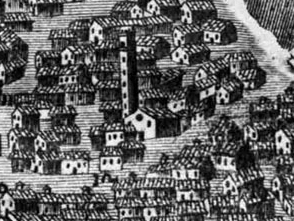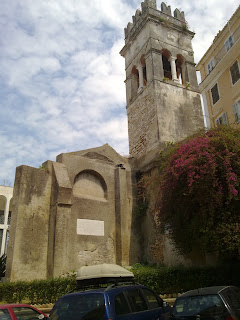On the Eugeniou Voulgareos street, which happens to be maybe the most central and commercially important of the town, stands a tall old campanile without a church attached to it. Some tourists stop to take a picture of it but few of them know the importance of that monument. Neither the majority of the local people do.
The campanile was part of the Annunziata catholic church ("Lontsiada" in the local corfiot dialect), which originally was a monastery, was built in 1394 by the napolean house of Capece, which was one of the oldest in Italy. Then the area was known as the "Borgo", which in the italian language means "suburb", as the actual centre of Corfu town, until the end of the 16th century, was the Old Fortress peninsula. The monastic complex was dedicated to the Annunciation of Virgin Mary and to Santa Lucia ("Aghia Loukia" in greek) and was run by the order of Saint Augustine. The inauguration of the monastery was on the 7th of January of 1394 (Saint John's day for the Orthodoxs) and it draw a lot of people from all over Corfu.
In 1713, the Archibishop Augustus Antonius Zacco abolished the monastery of the "Augustinians of Palestine", as it was then known and only the church remained in use from the complex. The church's architecture wasn't notable. The nave was seperated in three arched parts and the main entrance was reached by a ladder made by red marble. The campanile, which it is left intact, bears the venetian emblem of Corfu on it and there were some corfiots sculptured scenes as well. Inside the church, the remains of the latin soldiers who were killed in the "Battle of Lepanto" ("Battle of Naupaktos") in 1571 were interred. During that time, the internationally famous spanish writer, Miguel de Cervantes, being traumatized in his left leg, lived for a year in the precincts of the monastery, writing the "Journey in Parnassus" ("Viaje al Parnaso").
- The area around Annunziata monastery from an old Corfu Town map, cerca 1700. Notice how different looks the campanile.
- Eugeniou Voulgareos street (then known as "Cale dell' Acque" in the venetian dialect or Strada Real), the vicinity of "Annunziata", in 1836, watercolour by Samuel Prout. At the far right, the campanile and the steps which led to the entrance of the church.
In 1891, the 500 years of the monument were celebrated. Unfortunately, the Annunziata church was bombed by the Nazi Germans in the nightmarish 14 September of 1943. In fact, only the roof was completely destroyed. The monument stayed there ruined until 1953 when, without a reason and without taking into account the importance of the monument, the local government demolished it, leaving only the campanile intact.
Annunziata, shortly after the bombing in 1943 - notice the church's almost intact façade:
The monument in 1960s - the church was already demolished:
In the recent years, the government of Italy volunteered financialy to revive it. But the local government didn't show any interest in this project so nowdays Annunziata's campanile is being left to rot, a victim of bureaucracy and indifference.
Personally, I would like to see it fully renovated, with efficient lighting during the night. Moreover, the whole church could be rebuild and be appreciated as a monument of great historic importance. Also, the street outside it should be fully pedestrianised because today there is a total useless roundabout with many vehicles parked around it.
- "Save Annunciata": A Facebook group dedicated in the revitalisation of Annunziata: http://www.facebook.com/group.php?gid=313723857937&v=info
-A short photographic tour around the monument:
- Map of the area around the monument
Προβολή μεγαλύτερου χάρτη
The campanile was part of the Annunziata catholic church ("Lontsiada" in the local corfiot dialect), which originally was a monastery, was built in 1394 by the napolean house of Capece, which was one of the oldest in Italy. Then the area was known as the "Borgo", which in the italian language means "suburb", as the actual centre of Corfu town, until the end of the 16th century, was the Old Fortress peninsula. The monastic complex was dedicated to the Annunciation of Virgin Mary and to Santa Lucia ("Aghia Loukia" in greek) and was run by the order of Saint Augustine. The inauguration of the monastery was on the 7th of January of 1394 (Saint John's day for the Orthodoxs) and it draw a lot of people from all over Corfu.
In 1713, the Archibishop Augustus Antonius Zacco abolished the monastery of the "Augustinians of Palestine", as it was then known and only the church remained in use from the complex. The church's architecture wasn't notable. The nave was seperated in three arched parts and the main entrance was reached by a ladder made by red marble. The campanile, which it is left intact, bears the venetian emblem of Corfu on it and there were some corfiots sculptured scenes as well. Inside the church, the remains of the latin soldiers who were killed in the "Battle of Lepanto" ("Battle of Naupaktos") in 1571 were interred. During that time, the internationally famous spanish writer, Miguel de Cervantes, being traumatized in his left leg, lived for a year in the precincts of the monastery, writing the "Journey in Parnassus" ("Viaje al Parnaso").
- The area around Annunziata monastery from an old Corfu Town map, cerca 1700. Notice how different looks the campanile.
- Eugeniou Voulgareos street (then known as "Cale dell' Acque" in the venetian dialect or Strada Real), the vicinity of "Annunziata", in 1836, watercolour by Samuel Prout. At the far right, the campanile and the steps which led to the entrance of the church.
In 1891, the 500 years of the monument were celebrated. Unfortunately, the Annunziata church was bombed by the Nazi Germans in the nightmarish 14 September of 1943. In fact, only the roof was completely destroyed. The monument stayed there ruined until 1953 when, without a reason and without taking into account the importance of the monument, the local government demolished it, leaving only the campanile intact.
Annunziata, shortly after the bombing in 1943 - notice the church's almost intact façade:
The monument in 1960s - the church was already demolished:
In the recent years, the government of Italy volunteered financialy to revive it. But the local government didn't show any interest in this project so nowdays Annunziata's campanile is being left to rot, a victim of bureaucracy and indifference.
Personally, I would like to see it fully renovated, with efficient lighting during the night. Moreover, the whole church could be rebuild and be appreciated as a monument of great historic importance. Also, the street outside it should be fully pedestrianised because today there is a total useless roundabout with many vehicles parked around it.
- "Save Annunciata": A Facebook group dedicated in the revitalisation of Annunziata: http://www.facebook.com/group.php?gid=313723857937&v=info
-A short photographic tour around the monument:
-An old plaque in Latin which commemorates the Annunziata's inauguration ceremony of 1393.
- There is also a marble plaque in greek which say "Former catholic holy church "Annunziata", in here the remains of the dead christian soldiers of the Battle of Naupactus (1571) were interred"
- A beautiful sculpture on the wall in what used to be the façade of the long gone church.
- Map of the area around the monument
Προβολή μεγαλύτερου χάρτη


















1 comment:
Education is what survives when what has been learned has been forgotten. See the link below for more info.
#forgotten
www.ufgop.org
Post a Comment